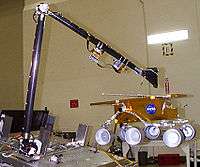Mars Surveyor 2001

The Mars Surveyor 2001 project was a multi-part Mars exploration mission intended as a follow-up to Mars Surveyor 1998. After the two probes of the 1998 project, Mars Climate Orbiter and Mars Polar Lander, were both lost, NASA's "better, faster, cheaper" exploration philosophy was re-evaluated, with a particular eye on the two 2001 project probes. As a result, the Mars Surveyor 2001 Lander was canceled in May 2000, but the decision was made to go ahead with its orbiter counterpart. The Mars Surveyor 2001 Orbiter, renamed 2001 Mars Odyssey, was launched April 7, 2001 reached Mars on October 24, 2001. After aerobraking from October 2001 until January 2002, Mars Odyssey began mapping the planet on February 19, 2002.
By December 15, 2010 the orbiter broke the record for longest serving spacecraft at Mars, with 3,340 days of operation, claiming the title from NASA's Mars Global Surveyor, which had arrived sooner than Odyssey but failed in 2006.[1] Some other active orbital missions during this period include Mars Express (since 2003) and Mars Reconnaissance Orbiter (since 2006), in addition there were a few landers and flybys.
Later, the lander spacecraft was adapted[2] to be used in the Mars Phoenix Lander which landed successfully on Mars in 2008. The Phoenix lander lasted 157 Martian sols on the surface of Mars' polar region and made several discoveries including observing snowfall and detecting the presence of perchlorate in the Martian soil.
Notes
- ↑ Press Release
- ↑ NASA, NASA Spacecraft Heads for Polar Region on Mars, RELEASE : 45-07
References
- "NASA - NSSDC - Spacecraft - Details". Retrieved February 4, 2010.
- "2001 Mars Odyssey Spacecraft". Retrieved February 4, 2010.
- "Mars Surveyor 2001". Retrieved February 4, 2010.
- "NASA Spacecraft Heads for Polar Region on Mars". Retrieved January 27, 2014.
